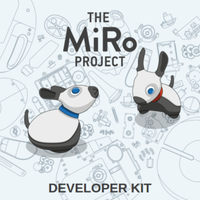Overview
This page will take you through installing the MIRO Developer Kit (MDK) and installing ROS (and Gazebo, if required).
Install MDK

On your workstation, unzip the MDK (MIRO Developer Kit) to a directory of your choice. This directory will be denoted ~/mdk throughout the documentation.
~/lib/mdk-170616-lite, and then make a symlink to this directory from ~/mdk; this will avoid version control problems if you update your MDK at a later date, and make it possible to copy-and-paste code direct from the documentation into your terminal.Test
You should now be able to run any of the tools in the MDK by changing into the bin folder for your machine's system. For example, here we test the miro_maint tool on a 64-bit Debian system.
Install ROS

The Robot Operating System (ROS) is a communications layer (amongst other things) that is popular in robotics R&D. MIRO exposes its interface as a ROS node, so you will need to install ROS on your workstation in order to communicate with the robot.
There are many web resources that will help you to install ROS (you might want to look at this, for example). This page is a quick install recipe for Ubuntu Xenial (16.04 LTS) and similar Linux distributions with ROS "kinetic". The procedure will probably be similar for other systems and versions, but watch out for minor changes that might be needed to paths or tokens (such as the token "kinetic"!).
Base installation
Follow the instructions at ros.org to install ROS kinetic on your workstation.
Or, roughly, enter the commands below. This will take, like, a billion years to complete.
Ubuntu 16.04 LTS

Linux Mint 18

$(lsb_release -sc) to the simpler token xenial, to give the following list of commands (i.e. install as if for Ubuntu Xenial).Configure installation for use with MIRO
If your robot or robots are to find the ROS master node on your workstation, they will need its IP address. To this end, you should now equip your workstation with a fixed IP.
Add the following lines to the file ~/.profile or ~/.bashrc, as preferred, on your workstation.
Replace the token [WORKSTATION_IP] with the fixed IP you have chosen for your workstation (and check that your MDK is indeed installed at ~/mdk, or else change that path as well).
Log out and back in (~/.profile) or just restart bash (~/.bashrc) to cause the above to take effect.
Test
You should now be able to run the ROS core as follows.
Leave it running
You should leave the ROS master running on your workstation, because we'll be using it when we Commission MIRO.
Install Gazebo

On your workstation, install the robot simulator Gazebo only if you plan to work with a simulated MIRO robot. If you plan to work with physical MIRO, you do not need the simulator.
There are many web resources that will help you to install Gazebo. This page is a quick install recipe for Linux Ubuntu 16.04.1 (Xenial) using ROS "kinetic" and Gazebo 7. The procedure will probably be similar for other systems and versions, but watch out for minor changes that might be needed to path names.
Base installation
To install Gazebo, enter the commands below. Do not install "gazebo7" package, because this is not updated regularly. Instead, install "ros-kinetic-gazebo-dev" which provides the version that marries up with your ROS installation (at time of writing, Gazebo 7.14.0).
Configure installation for use with MIRO
Add the following lines to the file ~/.profile or ~/.bashrc, as preferred, on your workstation.
Log out and back in (~/.profile) or just restart bash (~/.bashrc) to cause the above to take effect.
Test
You should now be able to invoke the simulator as follows.
dmesg.
See also the FAQ entry Why does Gazebo halt with errors like OgreRenderSystem?